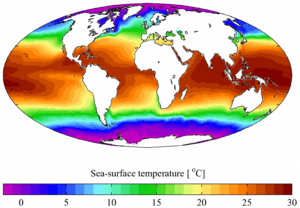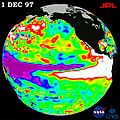Sea surface temperature facts for kids
Sea surface temperature (SST) is simply how warm the top layer of the ocean is. It's a very important measurement for understanding our planet's weather and climate. Even though it sounds straightforward, the "surface" can mean different things depending on how we measure it.
For example, satellites orbiting Earth can measure the temperature of a super thin layer, like the very "skin" of the ocean. But a floating buoy in the water might measure the temperature about one meter deep. Ships also take measurements, often from the water they use for their engines, which can be up to 20 meters below the surface. So, when we talk about SST, it's good to remember that it can come from different depths!
Contents
Why is Sea Surface Temperature Important?
Sea surface temperature plays a huge role in many things on Earth. It affects our weather, ocean life, and even how much ice melts.
Weather and Climate
- Driving Weather: Warm ocean water can evaporate more easily. This water vapor then rises into the atmosphere and forms clouds, which can lead to rain or storms. So, SST helps power our weather systems.
- Hurricanes and Typhoons: Tropical storms like hurricanes and typhoons get their energy from warm ocean waters. They need SSTs of at least 26.5 degrees Celsius (about 80 degrees Fahrenheit) to form and grow stronger.
- Climate Patterns: Changes in SST can lead to big climate patterns, like El Niño. During El Niño, warmer-than-usual water spreads across the Pacific Ocean. This can change weather patterns all over the world, causing droughts in some places and heavy rains in others.
Ocean Life
- Marine Habitats: Many ocean creatures, from tiny plankton to large whales, need specific water temperatures to survive. If the water gets too warm or too cold, it can harm their habitats and food sources.
- Coral Bleaching: When ocean temperatures get too high, coral reefs can become stressed. They might expel the tiny algae that live inside them and give them color. This is called coral bleaching, and it can cause corals to die.
Ice and Sea Level
- Melting Ice: Warmer ocean water can cause glaciers and ice sheets to melt faster. This adds more water to the ocean.
- Rising Sea Levels: As ocean water gets warmer, it also expands. This expansion, along with melting ice, causes sea levels to rise. This can affect coastal communities around the world.
How Do We Measure Sea Surface Temperature?
Scientists use several methods to measure sea surface temperature, from instruments in the water to satellites in space.
Measuring from Space
- Satellites: Satellites are a great way to measure SST over large areas. They use special sensors that detect the infrared energy (heat) coming from the ocean's surface. This allows scientists to create detailed maps of ocean temperatures around the globe.
- Global View: Satellites can measure the temperature of the very top layer of the ocean, often just a fraction of a millimeter thick. This gives us a wide, consistent view of ocean temperatures.
Measuring in the Ocean
- Buoys: Thousands of floating buoys are spread across the oceans. These buoys have thermometers that measure the water temperature at different depths. They send their data back to scientists, giving us real-time information.
- Ships: Ships also collect SST data. They might use thermometers lowered into the water or measure the temperature of the water they take in for their engines. While useful, these measurements can vary in depth.
- Argo Floats: There are also special robotic floats called Argo floats. These floats dive deep into the ocean and then rise to the surface, measuring temperature and salinity (saltiness) as they go. They send their data to satellites when they reach the surface.
What Are Average Sea Surface Temperatures?
Sea surface temperatures vary a lot depending on where you are in the world.
- Equator: Near the equator, where the sun's rays are strongest, SSTs are generally warmest, often above 25 degrees Celsius (77 degrees Fahrenheit).
- Poles: As you move towards the North Pole and South Pole, the water gets much colder, often close to freezing point (around 0 degrees Celsius or 32 degrees Fahrenheit).
- Seasonal Changes: SSTs also change with the seasons. In summer, the water is warmer, and in winter, it's colder.
Understanding sea surface temperature helps scientists predict weather, study climate change, and protect marine life. It's a key part of understanding our amazing planet!
Images for kids
-
Sea-effect snow bands near the Korean Peninsula
See also
 In Spanish: Temperatura de la superficie del mar para niños
In Spanish: Temperatura de la superficie del mar para niños









